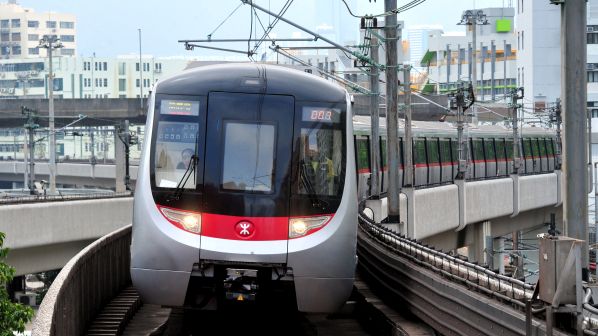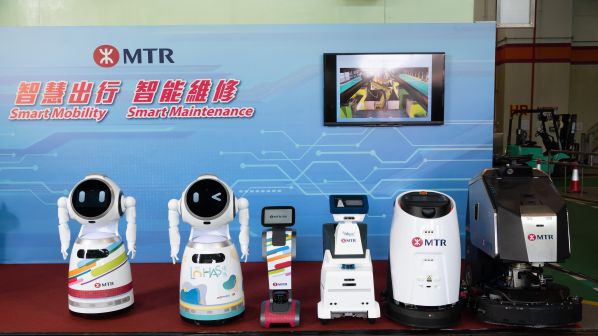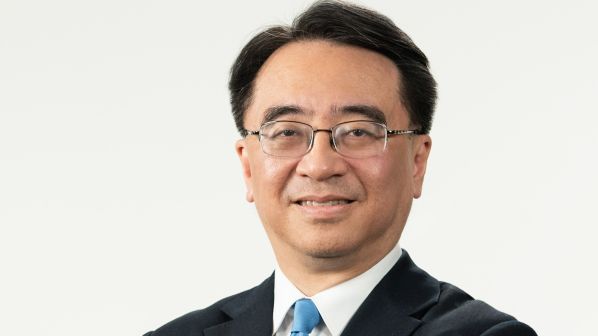WHILE the rest of the world was waking up to Covid-19 in February and March, Hong Kong was already busy dealing with the imminent threat to public health posed by the virus.
The Hong Kong government took the unprecedented step of closing its borders to international visitors from January 30 as infections increased. This included cross-border rail services on both the high-speed and conventional links from Kowloon to Shenzhen and Guangzhou. MTR also reduced the frequency of its metro services as people were encouraged to stay at home to limit the spread.
As well as running fewer off-peak trains, MTR instituted significant changes in everyday operation of Hong Kong’s 174.7km, 11-line heavy rail and 36.2km light rail networks.
All front-line staff must wear masks when on duty. Staff are also requested to measure their body temperature before they start work to ensure they are fit and well. Hand sanitiser has been made available to passengers and under measures introduced in mid-July, all passengers must wear a face mask when travelling on public transport. This was extended to all indoor public places during the week of July 20.
Even before the outbreak of Covid-19, MTR employed a strict train cleaning regime, including the use of nano silver-titanium dioxide, a photocatalytic germ-killing spray, on train surfaces and other commonly touched areas in stations to reduce the chance of cross contamination. This has been ramped up during the pandemic through the deployment of 20 robots which use Vaporised Hydrogen Peroxide (VHP) to deep clean trains at depots as well as stations.
“From our experience of Sars 14 years ago, we were quite prepared to deal with coronavirus, we asked our staff to put on face masks and implemented our contingency plan.”
Dr Jacob Kam, MTR CEO
Developed jointly by MTR and Avalon Biomedical, Hong Kong, the robots are designed to automatically spray the hydrogen peroxide solution, which is atomised to a specific concentration to ensure that disinfectants penetrate small and difficult to reach gaps. The robot operates automatically or via remote control and MTR says it normally takes about four hours to clean an eight-car train in automatic mode.
Unlike other railways which are following social distancing protocols, MTR is not enforcing the strict separation of passengers. There are no signs on trains or platforms to inform passengers of a 1.5-2m limit and MTR CEO, Dr Jacob Kam, says the operator trusts people to behave appropriately, wear masks and keep their distance.
“From our experience of Sars 14 years ago, we were quite prepared to deal with coronavirus,” Kam told IRJ. “We asked our staff to put on face masks and implemented our contingency plan. This included stepping up our cleaning regimes and ventilation in our system and so on. It was not a complete lockdown here, people were still able to move around, but stay at home if possible. If you compare patronage for example in Australia and Britain, where they only had around 10% of normal passenger numbers, during our worst period we still had 50% of normal patronage, so our situation is slightly different from other places.”
Nevertheless, even at a low of 81.4 million passengers in February, which was down 47.5% year-on-year, MTR is feeling the pinch. The operator carried a total of 637.2 million passengers in the first six months of the year, a fall of 37.7% compared with 1.022 billion passengers in the first half of 2019 where ridership fell 2.5% following civil disturbances in the region.

This result translates into an expected fall in profits from recurrent businesses from $HK 2.6bn ($US 340m) in 2019 to $HK 400m in the first half of 2020. Overall, MTR is expecting to report a $HK 400m loss in the first half, compounded by an expected property revaluation loss of $HK 6bn on the group’s investment property portfolio, compared with a $HK 2.1bn gain in the same period in 2019. This result more than offset a $HK 5.2bn profit from property development businesses following the success of the Lohas Park Package 6 project.
Kam says the nature of MTR’s property development model is to create communities around its stations. This includes the development of local businesses who rent spaces in stations and shopping malls owned by MTR. But even this much-heralded model is not immune to the recent challenges. With these businesses suffering during the pandemic due to the fall in patronage, Kam says the operator was quick to offer support through rebates on rents to some tenants.
“We offered half rent rebates, and for some tenants extended this to more than half their rent,” Kam says. “In the next few months, we will gradually reduce these rebates as business comes back. It has been a major success to use increases in property values to subsidise railway operations. Fare increases have been substantially reduced but with lower patronage we have had to reduce rents, which makes overall operation much more challenging.”
MTR carried 125.1 million passengers in June, the best since 140.2 million in January, but still someway short of the 167.7 million transported in June 2019, when patronage was down due to the protests. While MTR retained its peak hour frequency during the pandemic, as the recovery took hold, the railway began to gradually restore its off-peak service from July 1. It also announced several special offers to attract passengers back to its services. These include a 20% rebate for every Octopus smartcard trip and a $HK 100 price reduction on Monthly Pass Extra and MTR City Saver passes up to December.
“Tourists and business visitors are a very important part of city life. In addition, we carry a lot of international traffic to mainland China. All of these were practically cut off during the pandemic.”
Dr Jacob Kam
However, these initiatives suffered a setback just a few weeks later. A surge in Covid-19 cases in mid-July led the government to issue limitations on social contact. Demand for rail journeys fell significantly, leading MTR to reduce off-peak frequencies on the Tsuen Wan, Kwun Tong, Island, South Island, Tseung Kwan O, East Rail and West Rail lines to three-and-a-half to eight minutes intervals from July 22 compared with three to six-and-a-half minutes previously. Tung Chung Line and Tuen Ma Line frequencies were also increased to 10 and 9.8-minute frequencies respectively. The Disneyland Resort Line and the Airport Express remain unchanged at respective 20 minute and 15-30-minute intervals.
“Hong Kong is a small city but critically it is an outward facing city,” Kam says. “Tourists and business visitors are a very important part of city life. In addition, we carry a lot of international traffic to mainland China. All of these were practically cut off during the pandemic. As an outward looking economy, we have to wait for the bulk of international travel to resume before we can get back to anything like normal.”
Overall, Hong Kong’s economy was on course to record an 8% year-on-year drop in GDP in 2020 in June. Despite the dire forecasts, Kam says he is heartened by a recent sale of 100 apartments in two days. “Hopefully this is a sign that people are still confident in the future of the economy,” he says.
Network expansion
Coronavirus does not appear to have impeded MTR’s ambitions to expand its rail network. The railway has outlined seven possible extensions to the network for delivery over the next decade or so in its $HK 110bn Railway Development Strategy 2014, and issued a planning contract for the 1.5km Tung Chung extension in June.
Arup and Atkins will provide cost estimation and develop engineering designs and a viable construction programme for the project, which includes Tung Chung East station located between the existing Sunny Bay and Tung Chung stations, and a new Tung Chung West terminus. Construction is expected to begin in 2023, and the project is due to be completed in 2029.
As well as the Tung Chung extension, the Hong Kong government has granted MTR permission to proceed with the detailed planning and design of the Tuen Mun South project, a 2.4km extension of the West Rail Line from Tuen Mun to a new terminus at Tuen Mun South via a new intermediate station in Tuen Mun Area 16.
Other proposed projects include:
- Northern Link and Kwu Tung Station - a 10.7km regional line formed by linking Kam Sheung Road station on the West Rail Line with a new station at Kwu Tung on the Lok Ma Chau Spur Line
- Hung Shui Kiu Station - a new station on the West Rail Line between the existing Tin Shui Wai Station and Siu Hong Station
- East Kowloon Line - a new 7.8km line running in the northern East Kowloon area connecting Diamond Hill Station on the Kwun Tong Line (and the Sha Tin - Central Link) and Po Lam Station on the Tseung Kwan O Line
- South Island Line (West) - a new 7.4km line linking the South Island Line (East) to the West Island Line, and
- North Island Line - a new 5km railway on the northern shore of Hong Kong Island formed by extending the Tung Chung Line eastward and the Tseung Kwan O Line westward.
“The five other projects are still being discussed in the Hong Kong government,” Kam says. “We are in a unique position in that we can actually invest in these new lines ourselves, we don’t necessarily need government investments. Many railways around the world are loss-making businesses and struggle to makes ends meet. We can use the property development model around the site to pay for the extension.”
The property development model was applied to three of the five projects in MTR’s previous 55.6km network expansion programme (see panel). This included a high-speed rail connection to mainland China from a striking new station at West Kowloon.

However, delivery of some of these projects proved difficult, and one, the Sha Tin - Central link, is still underway.
At $HK 90.7bn, the 17km connection is the costliest in MTR’s history and was originally scheduled to open in mid-2019. The line has 10 stations and the 6.8km Tuen Ma Line (TML) Phase 1 between Tai Wai and Kai Tak opened on February 14, adding two new stations at Hin Keng and Diamond Hill. The 4.2km Kai Tak - Hung Hom section is now slated to open in the third quarter of 2021 and is more than 90% complete. The 6km Hung Hom - Admiralty section, which is a southern extension of the East Rail Line beneath Victoria Harbour, will be completed in the first quarter of 2022.
Problems with these remaining sections compounded delivery of the project, specifically poor construction and a cover-up of mismanaged work on expanded platforms at Hung Hom, which emerged in May 2018. MTR told IRJ when news of the problems broke that several construction changes had been made in works on the platform slab at the Hung Hom station extension by the contractor without full documentation and formal submissions to MTR’s project management team. The government was also not informed of the changes.
A report from a Hong Kong government-appointed inquiry released on May 12 heavily criticised MTR and contractor Leighton Asia for “serious deficiencies” in their supervision of the project.
“The commission is fully satisfied that, with suitable measures in place, the station box structure will be safe and also fit for purpose,” the report says. “However, the commission recognised that in a number of respects, in the course of construction of the station box structure, there were unacceptable incidents of poor workmanship on site compounded by lax supervision, and that in a number of respects also, management of the endeavour fell below the standards of reasonable competence.”
“It’s a hard lesson, but one I think the whole company has learned from.”
Dr Jacob Kam
The controversy ultimately led to Kam’s predecessor, Mr Lincoln Leong, seeking early retirement. A host of other project leaders also resigned, and Kam says the report’s findings will spark major changes in project oversight at MTR.
“We used to pride ourselves on ‘safety first, quality always’ in everything we do, from railway operation to construction and so on,” Kam says. “This is one contract and the Sha Tin - Central is a large project with around 50 contracts. Even so, it is clear here that the quality management did not work properly. As a result, we are tightening the project conditions and have modified tenders to help us to keep track of what is happening to decrease the chance of mismanagement in the future. It’s a hard lesson, but one I think the whole company has learned from.”
Delivery of the 28km high-speed link to the border also proved more troublesome than expected. The Hong Kong section of the Hong Kong - Shenzhen - Guangzhou Express Rail Link opened on September 23 2018, three years later than initially planned and at $HK 84bn, 30% over the initial budget.
Difficult ground conditions, the flooding of a tunnel and the discovery of unmapped utilities all contributed to delays. Patronage on the line and the projected return on investment was also questioned in the domestic media. Yet Kam says traffic is steadily increasing. MTR increased the frequency of service to 17 long-haul train pairs in June 2019. This also increased the number of destinations reached by high-speed rail in mainland China from 44 to 58.
“High speed rail is reporting rising patronage,” Kam says. “The trend is quite encouraging. We have found that many more people around Hong Kong were planning to visit the mainland before Covid-19 and the closure of the border. The high-speed service is currently suspended, and we will see what happens because I expect after the border reopens it will take a little time for the traffic to return. However, it is a faster alternative to other modes to cross the border and is proving to be popular.”
The Sha Tin - Central link is equipped with CBTC and MTR is steadily rolling out the technology across its network in order to boost capacity.
Thales and Alstom are installing Thales’ Seltrac CBTC system across seven metro lines in Hong Kong under a €330m contract awarded in 2015. The suppliers are replacing existing Automatic Train Supervision (ATS), interlockings and Automatic Train Control technology in the control centre, onboard trains and at stations.
The rollout has faced some issues, notably a derailment on the Tsuen Wan Line in March 2019, which led to a suspension of CBTC testing for two months while an independent audit was conducted to confirm that safety requirements are being met. However, Kam says the benefits far outweigh these problems and MTR is pushing ahead.
Efficiency of operation
Indeed, Kam is a major proponent of deploying new technologies which improve efficiency of operation and boost network capacity.
Installation of CBTC is complicated by three-hour nightly maintenance intervals to conduct work. Kam says technology can help crews speed up the set-up of specific tasks as well as help to improve some inspection tasks which eat up valuable time.
For example, Kam says robots are conducting some train inspections. High-definition cameras on trains are supporting inspection of overhead lines, door systems, and track. Studies of Big Data collected from train assets can potentially boost train reliability and on train performance. “By monitoring these conditions in real-time, artificial intelligence applications are able to detect any developing problems early,” Kam says.

Robots are also supporting passengers, by acting as guides in stations and offering passenger information.
There is also a significant emphasis on introducing technologies that improve conditions for passengers. Connectivity is a major priority for MTR. 4G service is already available at all stations but use of this data is not free and Kam says it was a priority for MTR to install free Wi-Fi at stations and onboard trains. Some stations are also beginning to install 5G technology.
“We have an open approach to testing technology and working methods brought to us by potential suppliers as well as new apps developed in house.”
Dr Jacob Kam
In turn, anonymous tracking of mobile data is enabling the development of Big Data profiles, which is helping both internal and external developers to come up with apps and services for passengers. Recent examples include multimodal journey planners and a stop reminder system that alert passengers to alight when they are approaching their station.
“We have an open approach to testing technology and working methods brought to us by potential suppliers as well as new apps developed in house - we have a team working on this,” Kam says. “For example, we will include beacons in all stations which allow people to locate themselves underground with great precision.
“Locating oneself in one of our underground stations is very helpful, but now we are thinking about what we can do with that capability. Staff are coming up with new ideas such as an underground station map, an obvious application. We are taking this further, an example being to use the beacons to locate people on the network. A lot of students use the metro to go from home to school and back again. By switching on the beacon, parents can find where their kids are quickly and very simply.”
With on-time performance consistently at 99% and above, MTR continues to set the benchmark for operating an efficient urban mass transit railway network. Project delivery issues and more recently Covid-19 have presented a challenging set of circumstances for the railway. Increasingly connected passengers are also demanding more, meaning complacency is not an option to maintain this level of performance. Kam hopes he has found a formula that rights the wrongs of the railway’s recent problems and will meet these expectations now and well into the future.
“For us there are no limits as to what technology can do,” Kam says. “We are only limited by our imagination.”

